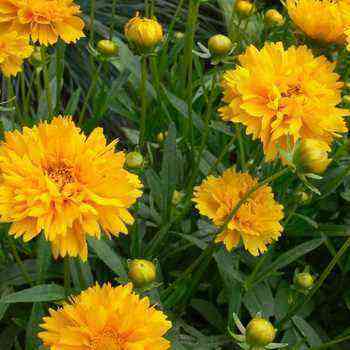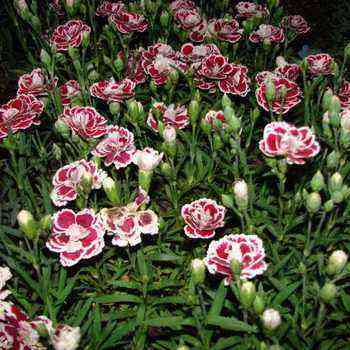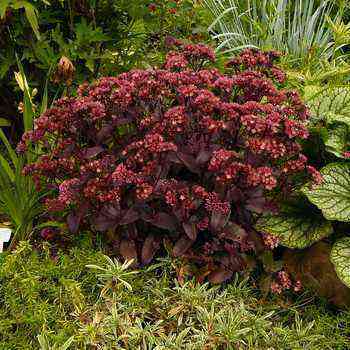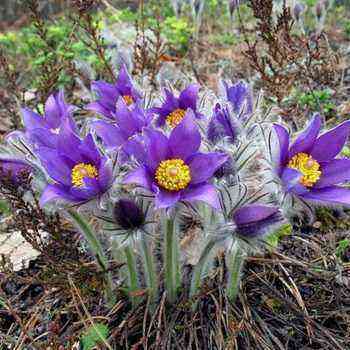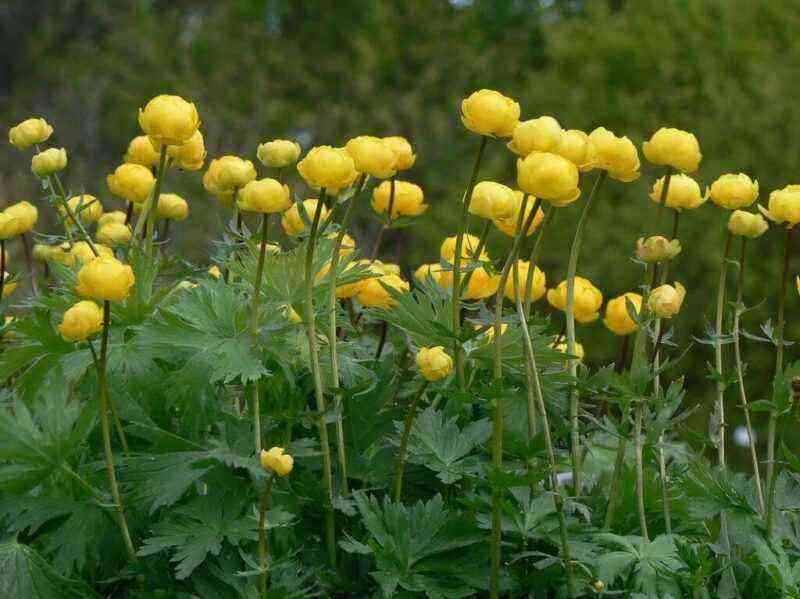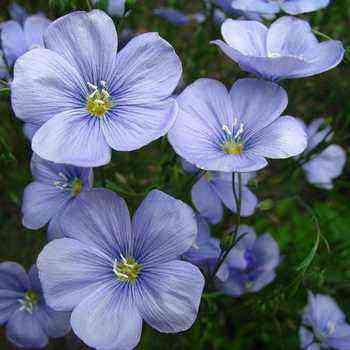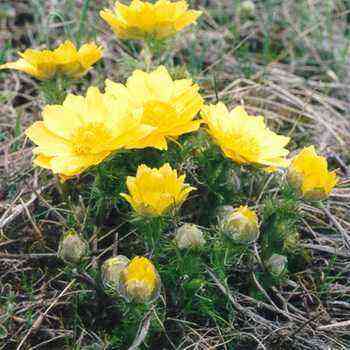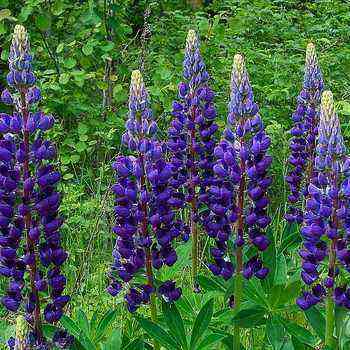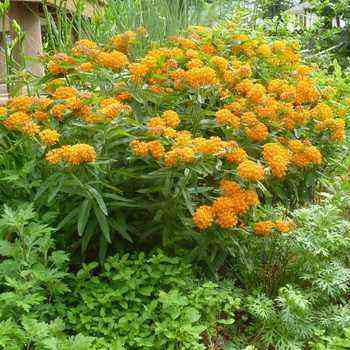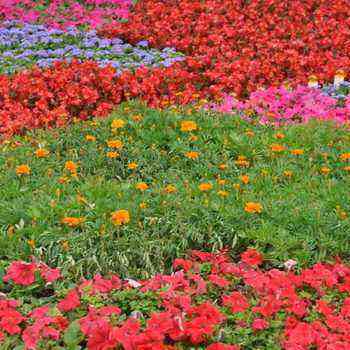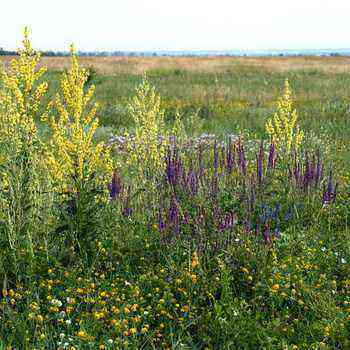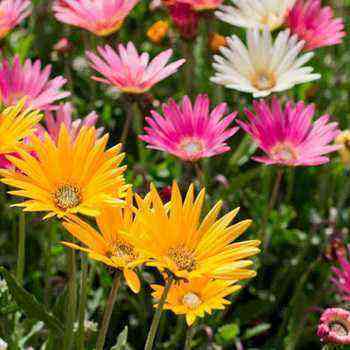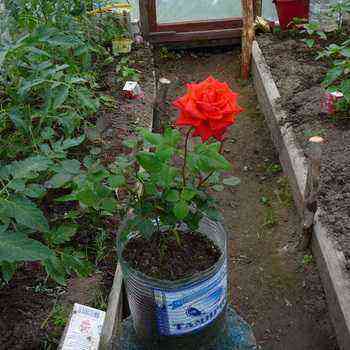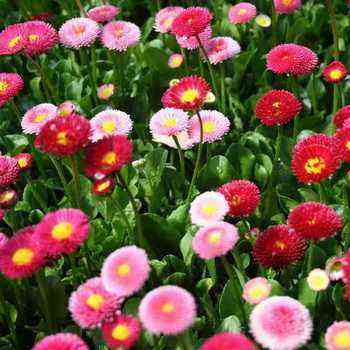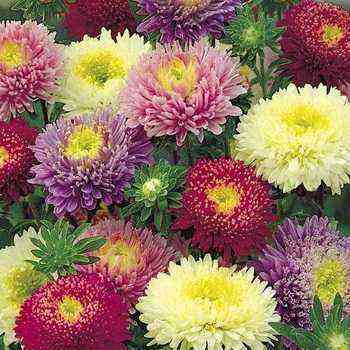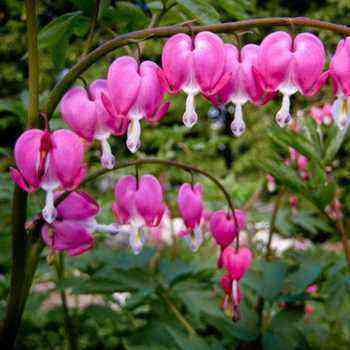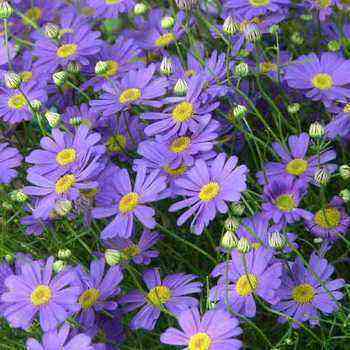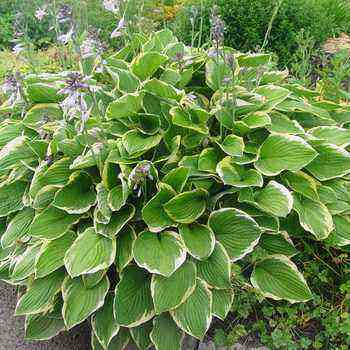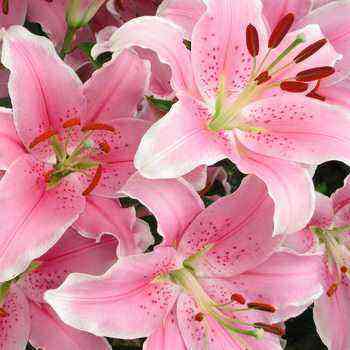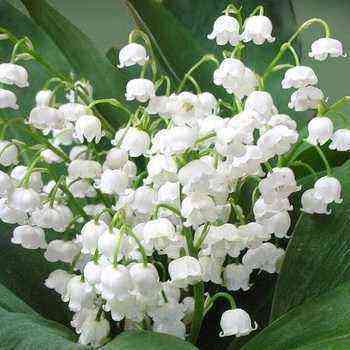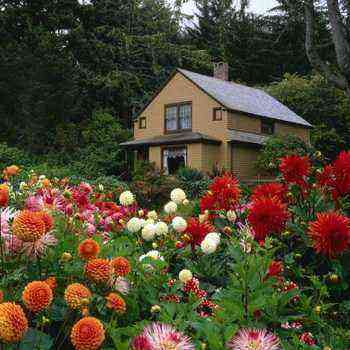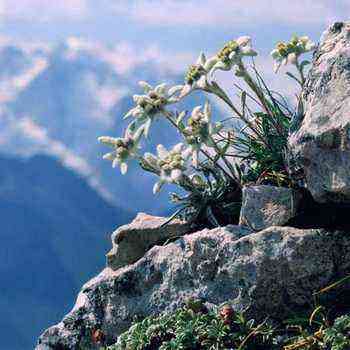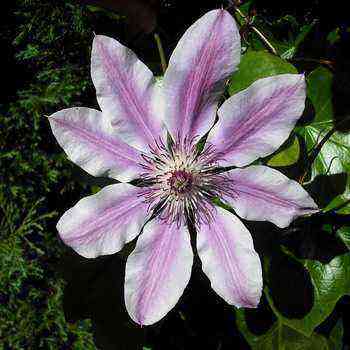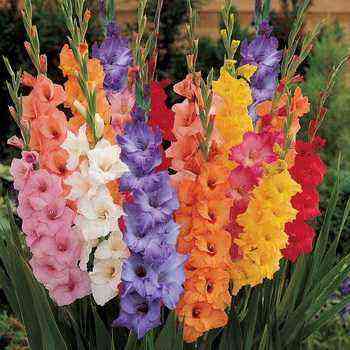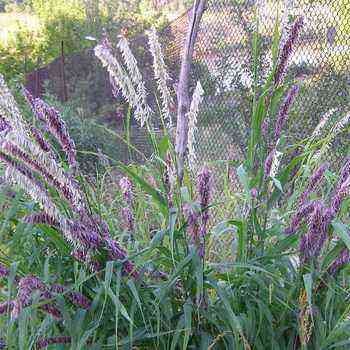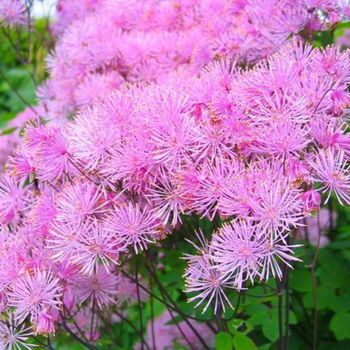 Buttercup family.
Buttercup family.
It is difficult to look away from a plant with fluffy inflorescences in warm colors and delicate delicate foliage. The basil flower looks elegant and sophisticated in the garden, towering majestically above other plants. Despite its spectacular appearance, this culture has a simple, docile nature. It is unpretentious to growing conditions, has high winter hardiness and is suitable even for those who have just started cultivating garden flowers.
In order for this unusual plant to please with its flowering, you need to follow some recommendations for its breeding. This article provides tips for growing a basil in the garden.
Under natural conditions, it grows in Europe, Siberia, the Caucasus, China, Japan. It is the closest relative of the catchment area. It has a similar openwork, only larger foliage.
There are 150 species of basilists, many of which have long been very popular among gardeners.
What does a perennial basilist look like?
Thalictrum is a perennial rhizome plant that is excellent for outdoor cultivation. It is appreciated for its decorative foliage and beautiful inflorescences. The root system is powerful, creeping, with numerous branches. The roots grow rapidly and penetrate to great depths. Stems are straight, slightly leafy or leafless, from 0.5 to 2 m in height. In some varieties, the leaves are formed on the stems, but most often they are collected in a basal rosette. The leaf plates are smooth, shiny, dark green. Below green, slightly pubescent.
The photo below shows that the flowers of the basil consist of stipules, painted in yellow and pink shades:

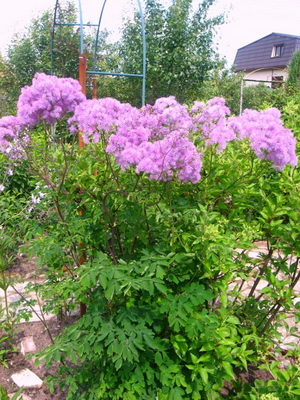
After the buds bloom, the sepals fall off and the stamens remain, due to which the flower becomes lush. The color of flowers can be different, depending on the type of perennial: yellow, purple, red, lilac. Often there are specimens with white buds. Flowering begins in June and lasts until July. Some varieties bloom until August. During flowering, the flowers give off a strong, pleasant aroma that attracts bees. For this reason, the plant is a good honey plant. The fruit is a sessile multi-root with large, oblong seeds. Formed after flowering.
It can grow in one place for 6-7 years without requiring a transplant and without losing its decorative effect.
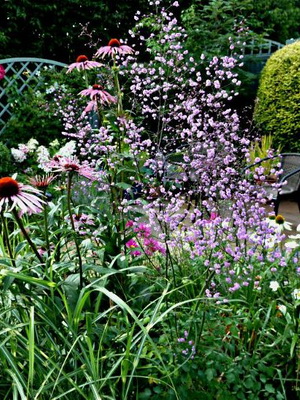
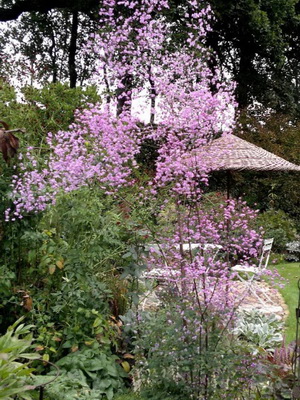
This culture, due to its spectacular appearance, is used in landscape design. Knowing how beautiful the basil looks, gardeners often plant it on the site among other ornamental crops.
Names and characteristics of species and varieties of basil with a photo

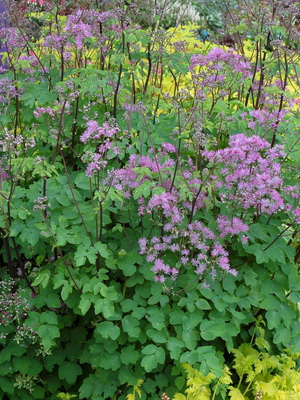
Basil (Thalictrum aquilegifolium).
Popular names: tall basil, gnawing grass, life-giving, zaselikha, zolotnik, devil’s gold, hare’s oxalis, lily, devil’s mint, silver grass.
Prefers forest edges and clearings in deciduous and mixed moist forests.


This type of basil is a tall plant of 50–120 cm, which grows in a compact bush. Leaves are twofold or threefold-pinnate with rounded leaves, silvery-green, shiny above and slightly pubescent below. Small lavender, white or pinkish flowers are collected in corymbose paniculate inflorescences. The fruit is a leaflet.
Blooms in June – July.
Below are the names of varieties of basil of a water-bearing species, with a photo and a characteristic, which helps the gardener choose among them the most suitable one for his flower garden.
Basil varieties:
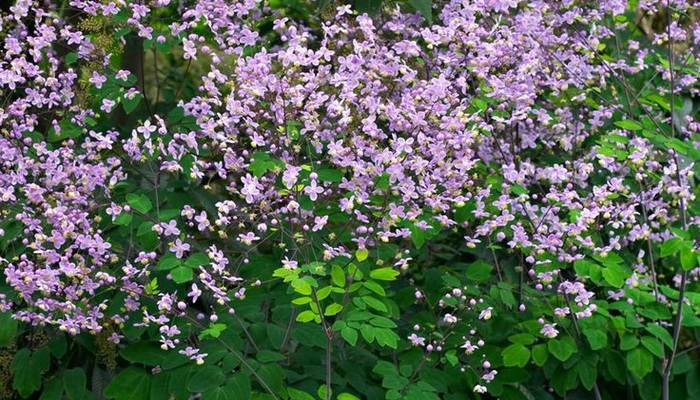
“Dwarf Purple” – undersized variety no more than 50 cm high. Inflorescences are bright pink;
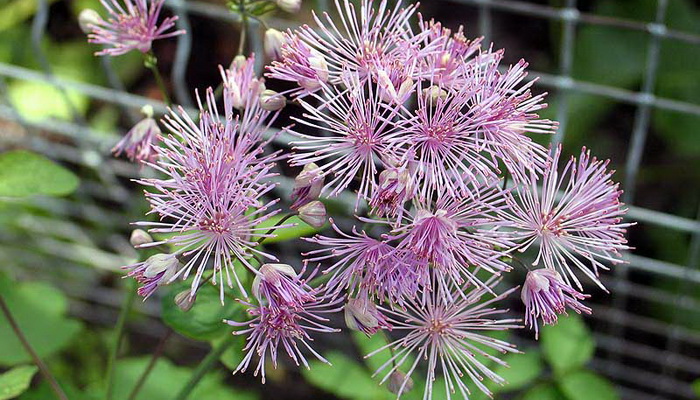
“Thundercloud” is a medium-sized variety about 70 cm high. It has bright purple inflorescences.
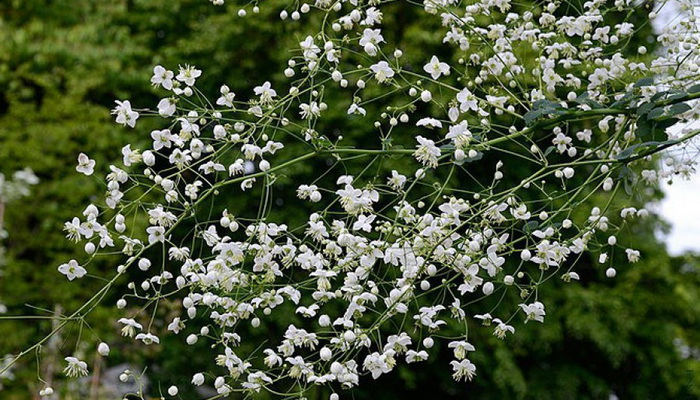
Album is a tall variety reaching about 1 m. Inflorescences are snow-white panicles.


Basil yellow (Thalictrum flavum).
Popular names: spool, gyren.
Prefers wet areas – along the banks of rivers, swamps, in damp meadows and glades.
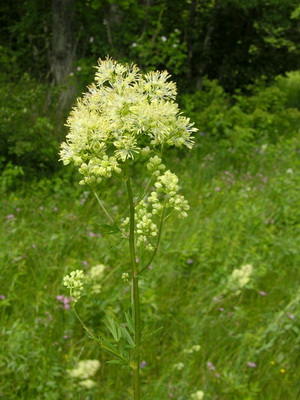

According to the botanical description, yellow basil is a herbaceous perennial plant that has a long, creeping rhizome and a furrowed, evenly leafy stem 60-200 cm long. or tridentate, the upper side of the leaves is olive green, the lower side is light. The inflorescence is a dense panicle, the flowers are greenish, twisted at the ends of the inflorescence, fragrant. Stamens are yellow, abundant. The fruits are ovoid, sessile achenes.
Blooms in June – July.
The plant looks very decorative.
Bred cultivars of yellow basil:
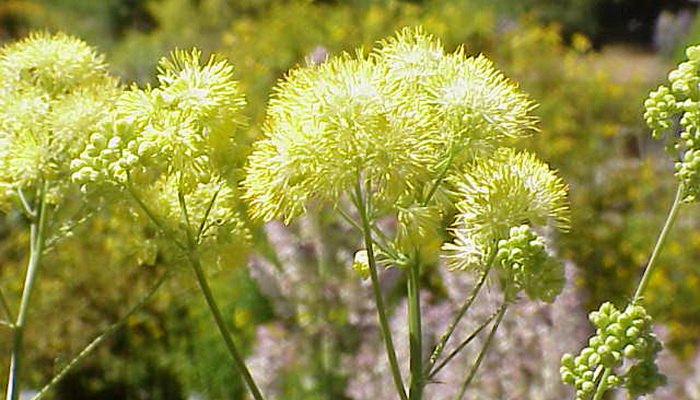
“Illuminator” – a variety whose leaves turn yellow when growing back;

Silver Sparkler is a very decorative variety with dark green leaves, on the surface of which there are numerous white streaks and stripes.
All varieties of this type of basil look very beautiful and unusual, therefore they always become a bright accent of the garden.
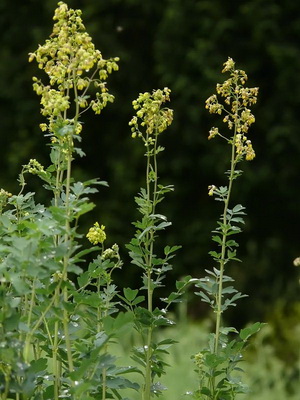

Small basil (Thalictrum minus).
Rhizome herbaceous perennial. The rhizome is horizontal, from 3 to 30 cm long; adventitious roots are numerous. Shoots are erect. Stems are straight, less often geniculate, 30 – 150 (less often up to 200) cm high, cylindrical, ribbed. The leaves are alternate, petiolate, stalk-embracing or with a short sheath (only the upper ones are sessile or short-petiolate, semi-stalk-embracing), broadly triangular in outline, 7-30 cm long and wide, thrice, quadruple-doublet, or thrice, quadruple-pinnate-compound. Leaflets 1 – 3 (4) cm long, 0.5 – 2.5 (4) cm wide, rounded, obovate, broadly elliptical, three-lobed or without lobes, 3 – 9-dentate, rounded at the base, less often wedge-shaped, on the lower side lighter. Leaves, like stems, glabrous or sparsely hairy. Inflorescence – broad-pyramidal or corymbose, sprawling multi-flowered panicle. Flowers drooping, small, greenish, of different shades, with 4, rarely 5, tepals of a simple perianth 3-4 mm long and numerous (10-30) long hanging stamens; pistils 5 – 12 (15). The fruit is a multi-nut. Nuts are sessile, ovate or ovate-elliptic, oblong-elliptical, ribbed, 2 – 4 mm long, 1 – 2 mm wide, with a straight or slightly bent nose 0.5 – 1 mm long.
The description of the small basil was supplemented with a photo, which can be seen below and consider all the features of this culture:
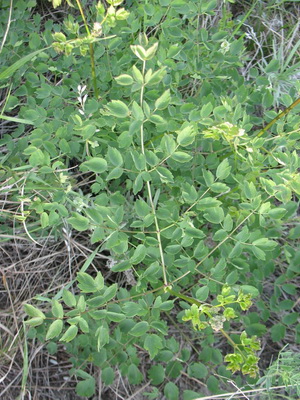
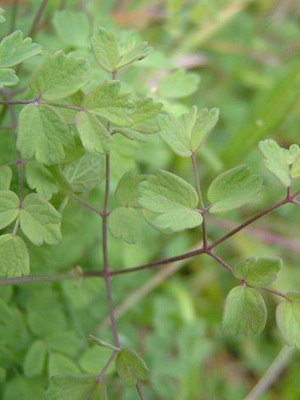
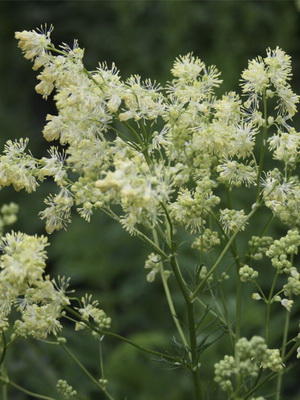
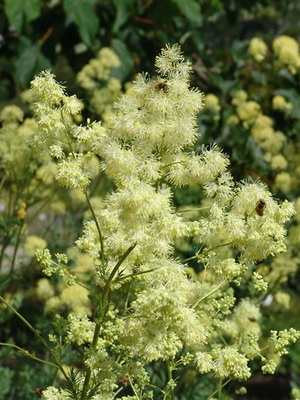
Light basil or shining basil, or narrow-leaved basil (Thalíctrum lúcidum).
Tall plant, reaching up to 150 cm in height. It has a short, powerful rhizome, from which several erect stems with curved nodes extend to the sides. Leaves are compound, narrow, up to 1 cm wide, linear, three to four pinnate, alternate, sessile. Above, the leaf plate is dark green, smooth, shiny. Below – green, with slight pubescence. The leaves are attached to thin petioles expanding at the base. The flowers are pale yellow, collected in an inflorescence – a pyramidal or thyroid panicle. Flowering begins in mid-June and lasts until August.
You can see what are the characteristic signs of a light basil flower in the photo shown below:
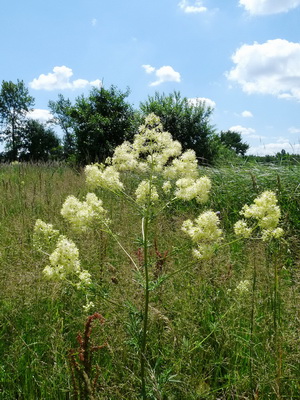


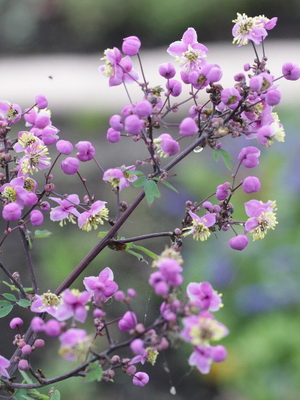
Alpine basil (Thalíctrum alpínum).
Herbaceous plant about 20 cm high. The stem is simple, glabrous or with one leaf. Leaves form at the base of the stem. The leaf plates are smooth, leathery, dark green. The flowers are purple, collected in a simple inflorescence – a brush.
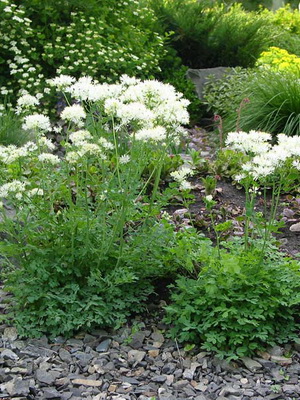

Basil filamentous (Thalictrum filamentosum).
Low-growing perennial plant up to 25 cm in height. It has a long, strong rhizome. This species covers the soil, forming a carpet of green pinnately separated leaves. The flowers are numerous, white, collected in an inflorescence – a panicle. Flowering begins in mid-May and lasts until early June. This culture, without transplanting, retains its decorative effect for 15 – 20 years. Looks most advantageous when grown around garden trees.
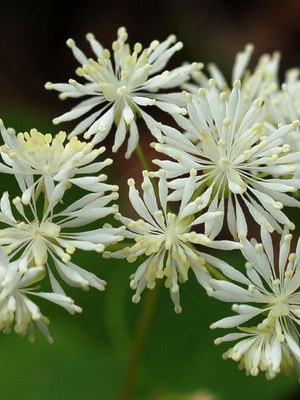
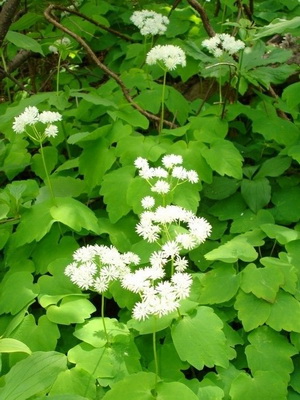
So that the gardener can better imagine the filamentous basil, the description of the flower is supplemented with the photo above.

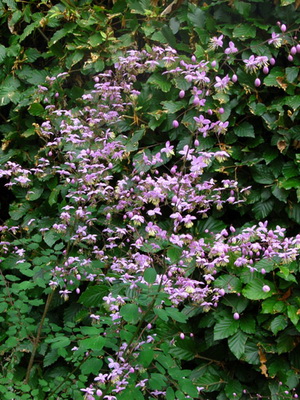
Basil dipteran (Thalictrum dipterocarpum).
The plant is up to 2 m high with graceful pink flowers, collected in inflorescences up to 15 cm in diameter and up to 60 cm long. The leaves are trifold, dark green. This type is winter-hardy, does not require shelter for the winter.
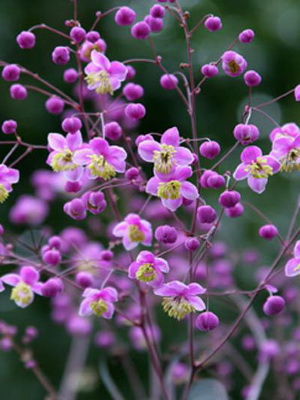
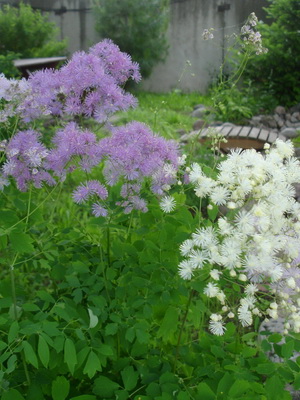
Basil of Delavey (Thalictrum delavayi).
The plant is up to 1.5 m high. The leaves are double and triple pinnate. The flowers are small, pink and purple, collected in a large, loose inflorescence – a panicle. Flowering lasts from early July to late August. The fruit is a leaflet with large, oblong brown seeds. Ripens at the end of summer. The winter hardiness of the species is average. In central Russia, shelter is needed for the winter.
Delavey Basil varieties:
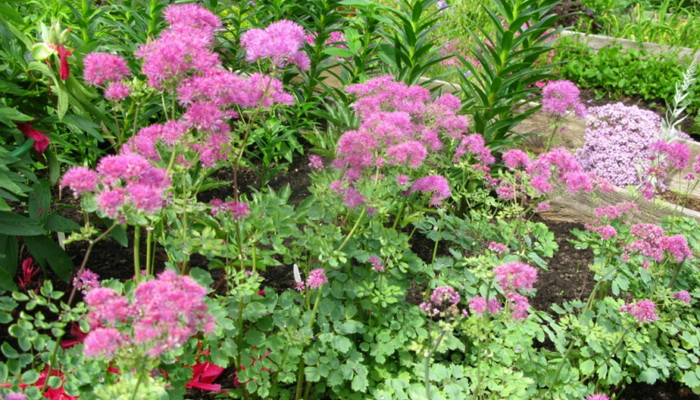
Hewlett’s Double is known to many gardeners for its vibrancy and attractiveness. The plant grows up to 1 m in height. It has lush double lilac-lilac flowers. Flowering begins in August;

Album has white flowers.

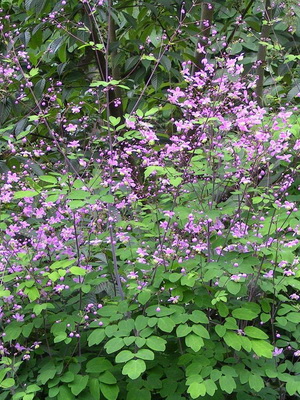
Rochebrunian basil (Thalictrum rochebrunianum).
One of the most beautiful species of basil, considered quite rare. Reaches about 2 m in height. It has reddish shoots with bluish-green leaves on it. The flowers are purple, fan-shaped.
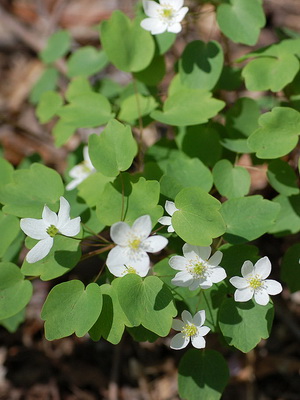
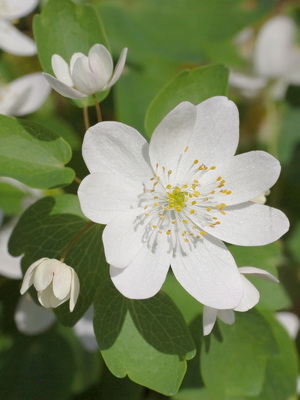
Basil anemic (Thalíctrum thalictroídes) is a herb for open ground, considered an early flowering perennial with a tuberous powerful root. Its stem is straight, thin, leafless, up to 30 cm high. The leaves are dark green, wide, rounded, three-lobed, slightly bent, up to 30 cm long. Flowers can be formed singly or be enclosed in umbrella-shaped inflorescences of 3-6 pieces each. The flowers are white or lavender-pinkish, spherical, with numerous yellow stamens. Bloom from April to May. The fruit is an oval achene, which, when ripe, acquires a brown color.
Basil growing conditions
This culture is unpretentious and does not cause much trouble for the gardener. But still, in order for the plant to bloom beautifully and magnificently and look neat, you need to periodically pay attention to it and create optimal growing conditions.
Location. It is necessary to decide in advance on the place where the basil will grow in the garden in the coming years, because this flower does not like frequent transplants. The right location will go a long way toward promoting lush flowering and plant well-being. It is recommended when choosing a site for planting to be guided by its natural needs. Under natural conditions, the basil grows on forest edges and near water bodies. It is best to plant it in partial shade, since it will stretch out in an open area and need abundant watering. The optimal place for this culture is under trees with a spreading crown and near water bodies.
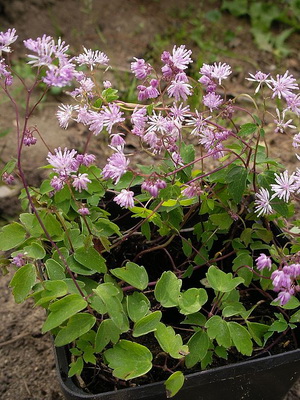

The soil. A plant that is completely undemanding to soils (it grows even on gravel gravel and clay) and growing conditions, it grows better and blooms longer in partial shade on well-moistened garden soils. For planting a basil on the site, sandy loam and loamy soils with neutral acidity are optimal. Before planting, the site must be dug up, the earth must be loosened, leveled.
Watering. Basil does not need regular watering and is considered a flower that successfully copes with temporary drought. Young, immature individuals, as well as bushes growing in direct sunlight, need abundant watering. It is enough to water adult plants only in extreme heat and drought.
Loosening. Caring for the basil also includes loosening the soil around the bush and weeding regularly. You need to loosen immediately after watering. This will help oxygenate the roots. In addition, it is necessary to regularly remove weeds and apply mulch to prevent moisture evaporation and overheating of the roots.
Top dressing. It is best to add top dressing when planting a basil, then this work will not be required for the next 3 years. After this period, it will be necessary to apply fertilizers. Top dressing is applied at the beginning of flowering. A mineral complex for garden flowers with a high nitrogen content is suitable for this. You can fertilize the soil around the basil in September. In this case, organic matter is suitable, which is embedded directly into the ground.
Pruning. Only one species needs pruning – the catchment. The rest of the species in preparation for wintering.
Preparation for wintering. All types and varieties of basil have high cold resistance and are able to withstand even severe frosts. Shelter for the winter requires Delaway’s Basilist.

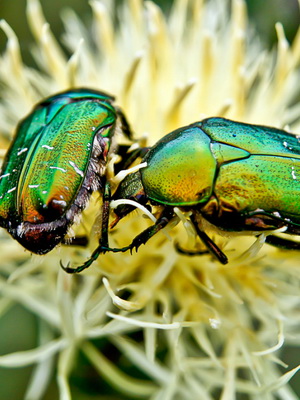
Growing problems. There is one malicious pest that eats flowers. This is a bronze flower beetle, a rather large green beetle with a bronze tint. Aphids also belong to the pests of this plant. In the fight against harmful insects help insecticides “Karbofos”, “Akarin”, “Iskra”, “Biotlin” and others. You need to spray the bush itself and the soil around it.
In addition, powdery mildew can affect this culture. You can find it by the white spots on the leaves. At the same time, blackening is observed on the stems, and the leaves begin to fall off soon after the appearance of these signs. A solution of copper sulfate, colloidal sulfur, Topaz, Fundazol are effective against powdery mildew.
Reproduction of basil by seeds
It is very rare among experienced gardeners to propagate the basil by seeds, since this work requires an investment of time and effort. In addition, with this method, maternal traits are not always inherited. If the gardener nevertheless decided to propagate this crop using seeds, he must adhere to several rules, then the result will be good.
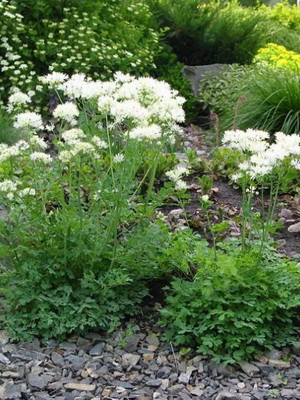
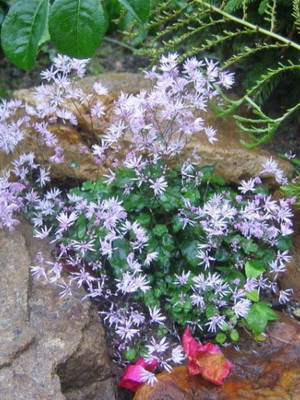
Please note that only fresh seeds can be planted. Therefore, you will have to collect them yourself. To do this, in July, several large inflorescences need to be wrapped with gauze or a dense cloth so that they do not scatter during the flowering period. After harvesting, remove the seeds in a dry, well-ventilated place and dry thoroughly. Can be sown directly into open ground before winter or in spring after warm weather. Before spring sowing, the seeds are stratified in advance by placing them in a cold place for 2 months. After that, they can be planted directly into the soil, or in pots for growing seedlings.
After planting basil seedlings in open ground, they need to be regularly looked after, because young plants should grow and get stronger. They can be planted in a permanent place in a year.
Flowering will begin in the second year after planting.
Propagation of basil by cuttings and division
When the basil is propagated by cuttings, the gardener will have less trouble than with the seed method, in addition, the plant will retain all the maternal characteristics.
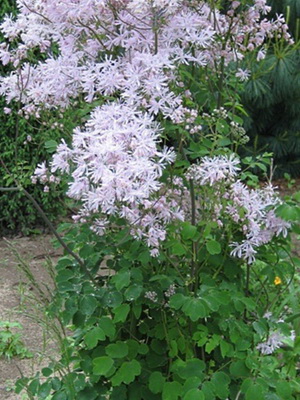
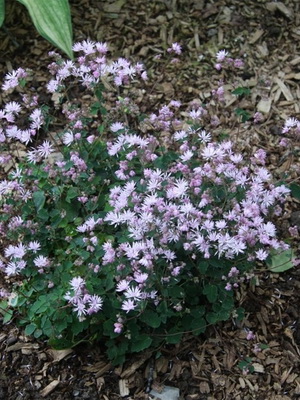
Cuttings are carried out at the end of April.For cuttings, shoots that have just appeared from the ground are taken with leaves that have not yet unfolded in early May. You can take a rhizome, but one that will have at least one internode and a heel. Before you start cutting the cuttings, the knife must be disinfected. After that, place the cut cuttings in a container with a growth stimulator, and then in boxes with light nutritious soil. Can be planted directly into the soil in an area protected from wind and direct sunlight. For cuttings, you should create mini greenhouses using glass jars, plastic bottles or polyethylene for this. After planting basil cuttings, you need to take care of them so that they take root as soon as possible. Greenhouses need to be opened daily to ventilate the seedlings. It is also necessary to monitor the condition of the earthen coma and moisturize it in a timely manner. By the end of summer, the cuttings should have a root system. After that, they can be put in their permanent place. Before planting, add compost or peat. Plants will bloom next year.
Reproduction by dividing the bush has been successfully practiced by many gardeners. This is an easy method of vegetative propagation, which gives excellent results.
The bushes are divided at the end of April or at the end of August. For the northern regions, a more suitable time is the end of August – beginning of September. They choose a large adult perennial basil bush, dig up and remove excess soil from the roots. With the help of a sharp knife or pruning shears, the roots are divided into parts so that at least one, two or three buds of growth and well-developed roots remain in the cuttings. Delenki are planted in open ground and watered abundantly. The distance when planting is 30-45 cm. Further, the seedlings are given regular care, which consists in watering, loosening the soil, and removing weeds.
How the work on planting and caring for the basil is carried out is demonstrated in the photo selection, which can be viewed below on the page:
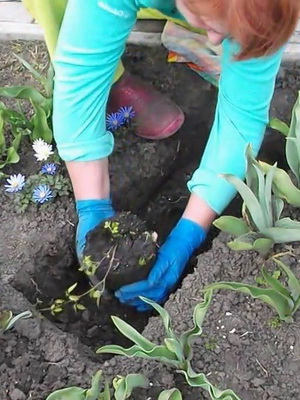
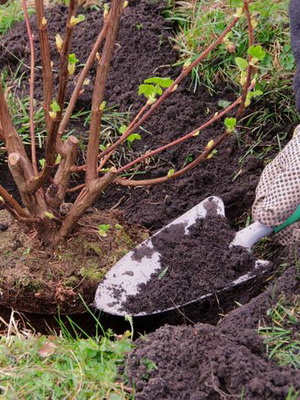
Choosing basil seedlings and planting them
When buying a basil sapling in a store, the gardener should pay attention to its varietal characteristics. It is recommended to purchase zoned varieties that have passed acclimatization in the region where they will be grown by the gardener. It is also important to pay attention to the height of the plant.
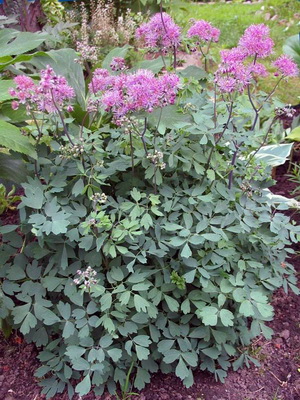
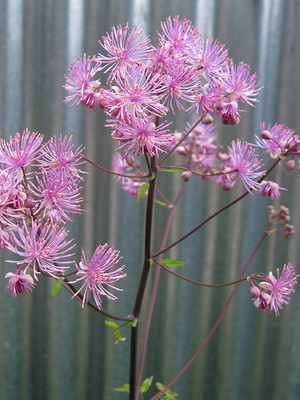
Before buying, planting material should be carefully examined, it should have a healthy appearance without any damage, strong roots and shoots.
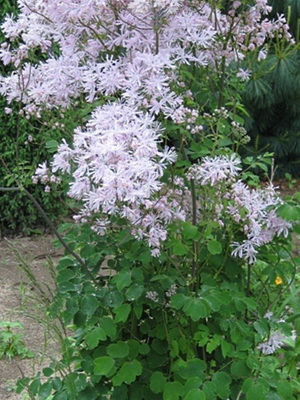

This photo shows a healthy basil plant, without any signs of diseases and pests, this is how high-quality planting material should be.
Planting is carried out in spring and autumn. Before carrying out this work, planting material is prepared. Seedlings with an open root system are placed in a solution of water and a growth stimulator for 5-6 hours. The seedlings in containers are kept in this solution for 40 minutes.
In the meantime, planting holes and potting soil are being prepared. The size of the pit depends on the size of the seedling. The distance between plantings should be at least 50 cm.
Mineral fertilizer and humus are added to the soil intended to fill the planting pit. The seedlings treated with a growth stimulator are placed in pits and covered with prepared soil mixture. After that, the bush is watered, the trunk circle is covered with mulch. Regular care will help the plant take root faster and adapt to a new location.
Basil application in the garden
This culture, due to its unusual appearance, has found wide application in landscape design. The next photo shows that the basil in the garden is planted in flower beds next to other variegated perennials.
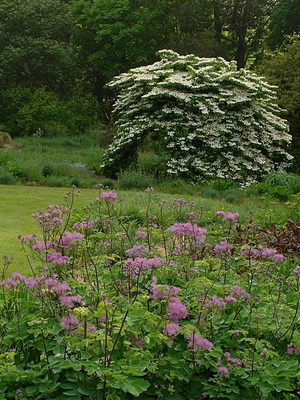

These flowers look beautiful along garden paths, moisture-loving species – near water bodies in combination with hosta, aquilegia, swimsuit, astilba, daylily.
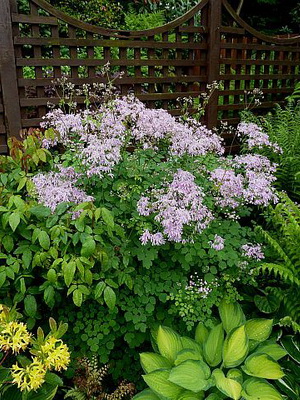
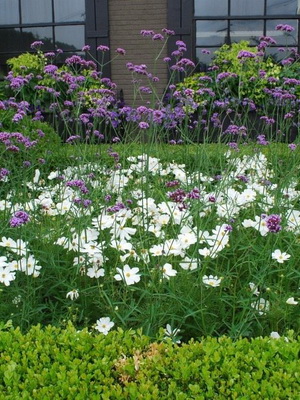
The plant is also used to decorate borders with shrubs, for example, euonymus and cotoneaster. Large species look elegant in single landings, presenting a complete, complete composition.
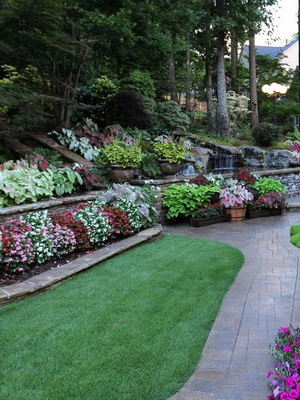
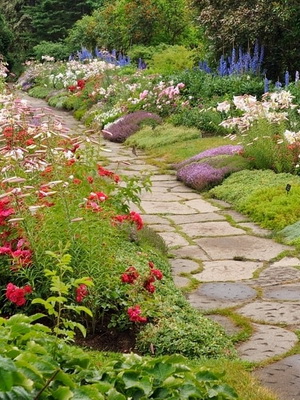
The flower garden will harmoniously look basil with bulbous cultures: daffodils, white flowers, hyacinths, licorice, lilies, tulips, saffron and others. One has only to choose the right color scheme.
Low-growing varieties are used as ground cover plants.
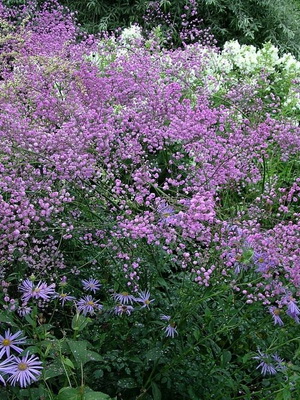

These flowers are suitable for cutting and arrangement, and the bouquet will be decorated not only with a lush, airy inflorescence, but also with the openwork foliage of the basil.
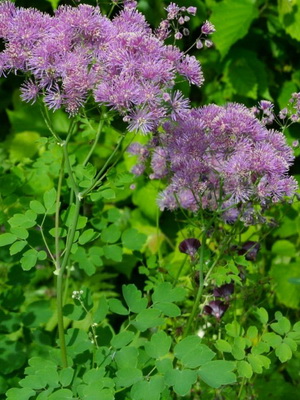

It is known that this culture is endowed with healing properties, which makes it possible to use it to create a medicinal flower bed, planting it together with similar healing plants.
